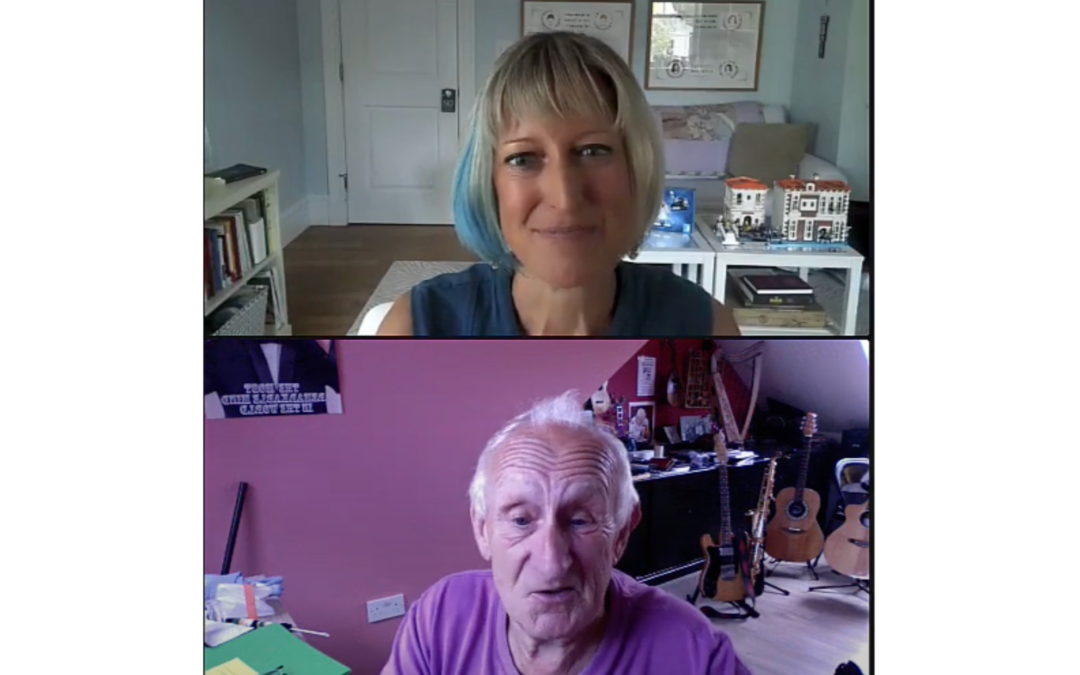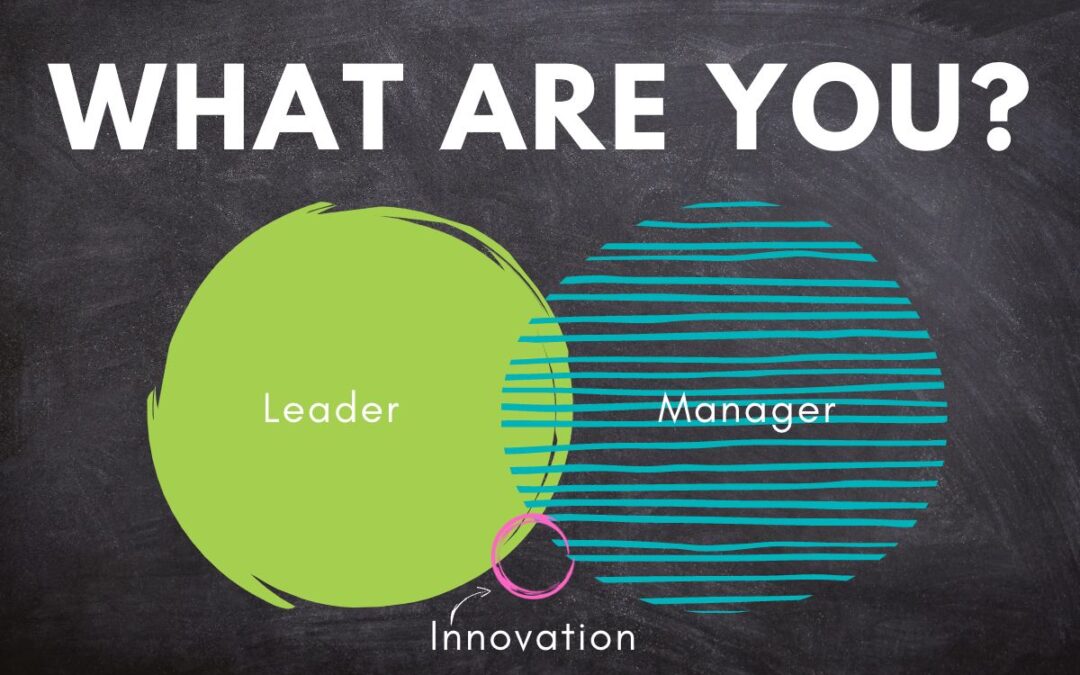


Are You an Innovation Manager or an Innovation Leader?
“Leader” is a word that gets thrown around A LOT.
Senior Management Teams are now Senior Leadership Teams.
Business schools no longer train managers. They “educate leaders.”
Training programs for specific skills are now “Leadership Development Programs”
If “innovation” is a buzzword (and it is), then “leadership” is the grand poo-bah of buzzwords.
Let’s get one thing straight.
“Leadership,” as it is commonly used, is the “extra-ordinarization of the mundane.”
But it’s not meant to be.
If you are a leader, you use your personal qualities and behaviors to influence and inspire others to follow you because they choose to (not because the org chart requires them to). Any person, anywhere in the org chart, can be a leader because leadership has nothing to do with your position, responsibilities, or resources.
If you are a manager, executive, or senior executive, you have positional power, usually earned. These terms put you in a particular place in the org chart, define your scope of responsibility, and set guardrails around the human and financial resources you control.
There is nothing wrong with being a manager (or executive or senior executive). Those positions are earned through hard work and steady results. They are titles to aspire to, be proud of, and use in a professional setting.
But if you run around telling people you’re a leader, well, to misquote Margaret Thatcher, “Being a leader is like being a lady. If you have to tell people you are, you aren’t.”
Are you a leader?
There are thousands of books on leadership, millions of articles, and hundreds of experts. I am not a leadership expert, but I know a leader when I meet one. The same is true for the people around you.
What do we see that helps us know whether or not you are a leader?
If the dozen articles I skimmed for this post are any indication, everyone has their own list, but there are some common items. To find the most frequently mentioned, I asked ChatGPT to list the qualities and behavior distinguishing leaders from managers and executives.
Here’s what I got:

Here are my reactions:
- Uh, ok. This leadership list feels like what an executive should do, but I guess the difference between the two (executives focus on strategy, and leaders inspire and connect) proves my point (which is a bit discouraging)
- It feels like some leadership qualities are missing (e.g., empathy, fostering psychological safety, inspiring trust)
- Kinda surprised to see other leadership qualities (do you need to “foster creativity and innovation” to be a leader?)
That 3rd thought led to a fourth – if “fostering creativity and innovation” is a quality shared amongst all leaders, then is there a difference between business, operational, and innovation leaders?
Are you an innovation leader?
I’ve worked for and with leaders, and I can say with absolute confidence that while each of them was a great leader, few were great leaders of innovation.
Why? What made them great leaders in business and operations but not in innovation?
Do you even need to be good at leading innovation if you’re good at managing it?
What does it even mean to be an “innovation leader?”
What do you think?
Off the top of my head, qualities specific to innovation leaders are:
- Patient for revenue, impatient for learning and insights
- Oriented to action, not evaluation (judging)
- Curious and questioning, not arrogant and answering
What am I missing (because I know I’m missing a lot)?
What characteristics have you experienced with innovation leaders that make them unique from other types of leaders?

Why You Need to Define “Innovation” (Hint: It’s All About Efficiency)
As the world around you becomes more volatile, uncertain, complex, and ambiguous (VUCA), you know that you need to build skills to navigate it and inspire others to follow your path.
But what if you are the source of ambiguity?
Because you are. Every time you speak.
The words we use always have clear meaning and intent to us but may not (and often don’t) have the same meaning and intent to others.
That’s why one of the first and most essential things a company can do when starting its innovation journey is to decide what “innovation” means. It may seem like an academic exercise, but it becomes very practical when you discover that one person thinks it means something new to the world, another thinks it’s a new product, and a third thinks it means anything commercialized.
Ambiguity = Efficiency?
“Innovation” isn’t the only word that is distractingly ambiguous. Language, in general, evolved to be ambiguous because ambiguity makes it more efficient. In 2012, cognitive scientists at MIT found the ambiguity–efficiency link, noting “words with fewer syllables and easier pronunciation can be ‘reused,’ avoiding the need for a vast and increasingly complex vocabulary.”
You read that right. In language, ambiguity leads to efficiency.
Every time you speak, you’re ambiguous. You’re also efficient.
The RIGHT level of Ambiguity = Efficiency!
In 2014, researchers at Pompeu Fabra University in Barcelona found that language’s ambiguity is critical to communicating complex ideas,
“the researchers argue that the level of ambiguity we have in language is at just the right level to make it easy to speak and be understood. If every single object and concept had its own unique word, then language is completely unambiguous – but the vocabulary is huge. The listener doesn’t have to do any guessing about what the speaker is saying, but the speaker has to say a lot. For example, “Come here” might have to be something like “I want you to come to where I am standing.” At the other extreme, if the same word is used for everything, that makes it easy for the speaker, but the listener can’t tell if she is being told about the weather or a rampaging bear.”
.
Either way, communication is hard. But Sole and Seoane argue that with just the right amount of ambiguity, the two can find a good trade-off.”
A certain level of ambiguity is efficient. Too much or too little is inefficient.
How to find the RIGHT level of Ambiguity for “Innovation”
In everyday life, it’s ok for everyone to have a slightly different definition of innovation because we all generally agree it means “something new.” Sure, there will be differences of opinion on some things (is a new car an “innovation” if it just improved on the previous model?). Still, overall, we can exist in this world and interact with each other despite, or maybe because of, the ambiguity.
Work is a different story. If you are responsible for, working on, or even associated with innovation, you better be very clear on what “innovation” means because its definition determines expectations and success for what you do. If it means one thing to you and a different thing to your boss, and a third thing to her boss, you’re in for a world of disappointment and pain.
Let’s avoid that. Instead:
- Define the word
- Get everyone to agree on the definition
- Use the word and immediately follow it with, “And by that, I mean (definition)”
Gently correct people when they use the word to mean something other than the agreed-upon definition. Once everyone uses the word correctly, you can stop defining it every time because its meaning has taken root.
So, the next time someone rolls their eyes and comments on the “theoretical” or “academic” (i.e., not at all practical, useful, or actionable) exercise of defining innovation, smile and explain that this is an exercise in efficiency.

3+ Tools to Make Navigating Ambiguity a Super Power
You are a leader. The boss. The person in charge.
That means you know the answer to every question, make the right decision when faced with every choice, and act confidently when others are uncertain. Right?
(Insert uproarious laughter here).
Of course not. But you act like you do because you’re the leader, the boss, the person in charge.
You are not alone. We’re all doing it.
We act like we have the answers because we’ve been told that’s what leaders do. We act like we made the right decision because that’s what leaders do in a volatile, uncertain, complex, and ambiguous (VUCA) world where we must work quickly and flexibly while doing more with less.
But what if we didn’t?
What if we stopped pretending to have the answer or know the right choice? What if we acknowledged the ambiguity of a situation, explored its options and interpretations for just a short while, and then decided?
We’d make more informed choices. We’d be more creative and innovative. We’d inspire others.
So why do we keep pretending?
Ambiguity: Yea! Meh. Have you lost your mind?!?
Stanford’s d.School calls the ability to navigate ambiguity “the super ability” because it’s necessary for problem-finding and problem-solving. Ambiguity “involves recognizing and stewing in the discomfort of not knowing, leveraging and embracing parallel possibilities, and resolving or emerging from ambiguity as needed.”
Navigating ambiguity is essential in a VUCA world, but not all want to. They found that people tend to do one of three things when faced with ambiguity:
- Endure ambiguity as “a moment of time that comes before a solution and is antagonistic to the objective – it must be conquered to reach the goal.”
- Engage ambiguity as “an off-road adventure; an alternate path to a goal. It might be rewarding and helpful or dangerous and detrimental. Its value is a chosen gamble. Exhilaration and exhaustion are equally expected.”
- Embrace ambiguity as “oceanic and ever-present. Exploration is a challenge and an opportunity. The longer you spend in it, the more likely you are to discover something new. Every direction is a possibility. Navigation isn’t simple. It requires practice and patience.
Students tend to enter the program with a resignation that ambiguity must be endured. They leave embracing it because they learn how to navigate it.
You can too.
In fact, as a leader in a VUCA world, you and your team need to.
How to Embrace (or at least Engage) Ambiguity
When you want to learn something new, the library is one of the best places to start. In this case, the Library of Ambiguity – an incredible collection of the resources, tools, and activities that professors at Stanford’s d.School use to help their students build this super ability.
It’s easy to get overwhelmed by the number of resources, so here are three that I recommend:
- What it is: A guide for selecting, framing, and communicating the intentions of a design project
- When to use it: When you are defining an innovation project and need to align on scope, goals, and priorities
- Why I like it: The guide offers excellent examples of helpful and unhelpful scoping documents.
- What it is: A tool to help individuals better understand the tolerance of ambiguity, especially their comfort, learning, and panic zones
- When to use it: Stanford used this as a reflection tool at the end of an introductory course, BUT I would use it at the start of the project as a leadership alignment and team-building tool:
- Leadership alignment – Ask individual decision-makers to identify their comfort, learning, and panic zones for each element of the Project Scoping Guide (problem to be solved, target customer, context, goals, and priorities), then synthesize the results. As a group, highlight areas of agreement and resolve areas of difference.
- Team-building – At the start of the project, ask individual team members to complete the worksheet as it applies to both the project scope and the process. Individuals share their worksheets and, as a group, identify areas of shared comfort and develop ways to help each other through areas of learning or panic.
- Why I like it: Very similar to the Project Playground concept I use with project teams to define the scope and set constraints, it can be used individually to build empathy and support amongst team members.
- What it is: A tool to build trust and confidence amongst a team working through an ambiguous effort
- When to use it: At regular pre-defined intervals during a project (e.g., every team check-in, at the end of each Sprint, once a month)
- What I like about it:
- Individuals complete it BEFORE the meeting, so the session focuses on discussing the dashboard, not completing it
- The dashboard focuses on the usual business things (progress against responsibilities, the biggest challenge, next steps) and the “softer” elements that tend to have the most significant impact on team experience and productivity (mood, biggest accomplishment, team balance between talking and doing)
Learn It. Do It.
The world isn’t going to get simpler, clearer, or slower. It’s on you as a leader to learn how to deal with it. When to slow it down and explore and when to speed it up and act. No one is born knowing. We all learn along the way. The Library will help. No ambiguity about that!
